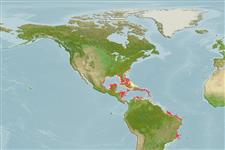Common names from other countries
Environment: milieu / climate zone / depth range / distribution range
Ecologie
; brakwater; diepteverspreiding 3 - 52 m (Ref. 415). Tropical
Western Atlantic.
Length at first maturity / Size / Gewicht / Leeftijd
Maturity: Lm ? range ? - ? cm
Massive to lobate. Surface has knob-shaped conules; 0.3 - 0.4 cm high; up to 1 cm apart. Dense like cheese. Oscules with membranes; 1 - 2 cm wide; on top of lobes (Ref. 415). External is usually bicolored but highly variable at purple, greenish, red-brown, orange or bright yellow. Internal color is bright lemon yellow. Exudate is dark; turns bluish after air exposure for about an hour.
Maximum depth reported taken from Ref. 128739. Common in reefs (Ref. 85482) and sea grass (Ref. 415). Also found in mangroves (Ref. 86836). Hosts alpheid shrimps in its canals (Ref. 86626). Inhabits coral communities. Found in shallow coral reefs and mesophotic depths (Ref. 128739).
Life cycle and mating behavior
Geslachtsrijpheid | Voortplanting | Kuitschieten | Eieren | Fecundity | Larven
Members of the class Demospongiae are hermaphroditic. Life cycle: The zygote develops into parenchymella larva (free-swimming) before settling down on a substrate where it grows into a young sponge.
Collin, R., M.C. Díaz, J. Norenburg, R.M. Rocha, J.A. Sánchez, M. Schulze, A. Schwartz and A. Valdés. 2005. (Ref. 415)
Status op de Rode Lijst van het IUCN (Ref. 130435)
Status bij CITES (Ref. 108899)
Not Evaluated
Not Evaluated
Gebruik door de mens
| FishSource |
Tools
Meer informatie
Leeftijd/GrootteGroeiLengte-gewicht parametersLengte-lengte parametersMorfologieLarvenAbundantie
Internet-bronnen
Estimates based on models
Preferred temperature
(Ref.
115969): 23.5 - 28, mean 26.5 (based on 290 cells).
Prijsklasse
Unknown.
